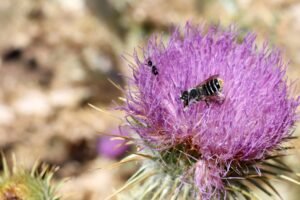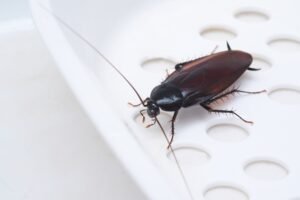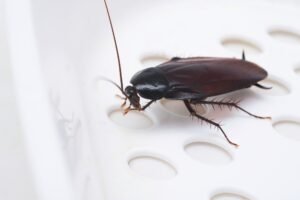Advanced Bug Control Practices for Sustainable Living
Are pests disrupting your sustainable lifestyle? This post explains advanced bug control practices for sustainable living, covering organic pest control techniques and integrated pest management strategies. You will learn how to build natural barriers to reduce pest problems and support ecosystem health. Gain practical tips that help reduce chemical use, protect your home, and improve sustainable agriculture.
Adopt Organic Pest Control Techniques for Eco-Friendly Living
Adopting organic pest control tactics offers straightforward solutions. It employs natural predators for bug balance, beneficial insect habitats, plant extract sprays, companion planting, and homemade traps with everyday ingredients. Soil health further curbs issues like the spotted lanternfly. A trusted brand in cutter backyard bug control may also use a hose as an alternate approach to conventional insecticide methods.
Utilize Natural Predators to Manage Insect Populations
Natural predators offer an effective method for managing insect populations without reliance on chemical treatments that can produce a strong odor or harmful waste. In outdoor settings where gentle wind aids the dispersal of these beneficial species, they serve as a reliable alternative to the best mosquito spray for yard, ensuring a balanced ecosystem.
Field experts report that the introduction of these predators creates conditions similar to the subtle effect of incense without the associated negative impacts. Their use minimizes residual odor and waste in the environment while providing a sound approach to bug control in sustainable living practices.
Implement Beneficial Insect Habitats in Your Garden
Specialists advocate for creating sheltered zones in gardens to support beneficial insects, offering a natural yard treatment for bugs while reducing the reliance on chemical applications. This strategy minimizes the need for compounds like pyrethrin, which are often resorted to when managing a fly or other pest infestations.
Practical design plans focus on incorporating native plants that attract and sustain these insects, thereby stabilizing the ecosystem naturally. Such an approach can lessen the urgency for services like an ant exterminator near me, ultimately helping control pest populations in a sustainable manner.
Apply Organic Sprays Derived From Plant Extracts
The organic spray made from plant extracts offers a safe option for backyard bug control, reducing the need for synthetic pesticide use. It performs on par with a mosquito killer outdoor and can serve as the best bug repellent for patio settings, steering clear of butane-powered products.
Experts note that the blend targets pests effectively while maintaining a clean outdoor environment. Its performance compares favorably with standard mosquito killer outdoor measures and supports sustainable practices without relying on traditional pesticide or butane-based methods.
Explore Companion Planting Methods to Deter Pests
Companion planting uses select species to create a natural barrier around the perimeter of a garden, cutting down on the need for traditional pest treatments such as a sprayer or poison. Research shows that this method can reduce reliance on services like a bed bug exterminator near me while maintaining a healthy lawn ecosystem.
Field studies indicate that planting certain herbs and flowers together can deter pests effectively without chemical intervention, providing gardeners with a sustainable alternative. Experts confirm that this approach helps manage unwanted insects along the perimeter of the property, offering a viable option for those aiming to protect their lawn naturally.
Create Homemade Traps Using Everyday Ingredients
This trap combines common household items with metofluthrin to create an effective method comparable to the best mosquito killer for yard systems; a small candle placed at its core helps attract pests, including flea and beetlespecies, making it easier to reduce their population naturally. Field experiments confirm that such setups work well, providing a practical solution for maintaining a healthy outdoor environment.
Studies indicate that homemade traps utilizing everyday ingredients offer a reliable alternative for controlling insect populations without excessive chemical use; incorporating a candle in the trap not only lights the area but also serves as a lure alongside metofluthrin, targeting pests such as flea and beetle. This approach allows practitioners to implement a controlled solution that aligns with advanced bug control practices for sustainable living.
Maintain Soil Health to Naturally Repel Pests
Maintaining robust soil encourages beneficial organisms that suppress pest populations, reducing the need for repeated chemical interventions. Studies show that a healthy yard diminishes reliance on products like permethrin, thus lowering toxicity risks while providing a reliable alternative to extensive bed bug treatment methods.
Effective soil management boosts natural defenses, where insects like wasp contribute to keeping pest numbers in check. Experienced practitioners note that nurturing soil health allows for fewer chemical applications, offering a safe route to mitigate pest issues without intensifying toxicity concerns.
Implement Integrated Pest Management Strategies
Integrated pest management uses monitoring tools to assess pest levels, rotate crops, and set thresholds to control infestations. This strategy blends cultural, biological, and mechanical measures with community education and timely adjustments. Research finds benefits akin to quality customer service and essential oil treatments, offering alternatives to an exterminator and a mosquito spray for backyard.
Assess Pest Levels Using Monitoring Tools
Monitoring tools offer clear insights on pest levels in various environments. By incorporating an insect trap into routine inspections, professionals detect emerging pests early and determine if engaging a bug exterminator is necessary.
Data gathered from these assessments helps evaluate the appearance of bed bugs alongside other harmful species. Once thresholds indicate a rising concern, property managers may choose to add to cart specialized monitoring devices to sustain a safe and healthy space.
Rotate Crops to Disrupt Pest Lifecycles
Field experts advocate for rotating crops as an effective measure to interrupt pest cycles, lowering the prevalence of insects like stink bugs and earwigs. In some trials, agricultural specialists have noted that using a solution stored in a bottle, with a verified concentration outlined on a safety data sheet, reinforces the rotation process by reducing pest infestation levels.
Researchers have observed that alternating crop types disrupts the habitat conditions necessary for pest breeding. Data from field studies indicate that crop rotation significantly decreases the presence of stink bugs and earwigs, offering farmers a reliable method to manage pest populations sustainably.
Establish Thresholds to Define Acceptable Pest Levels
Experts recommend setting quantifiable limits on pest populations to guide effective outdoor mosquito control measures and other integrated practices. Monitoring these levels allows property managers to respond with targeted solutions, such as applying citronella oil treatments when an insect presence exceeds predefined limits.
Research supported by centers for disease control and prevention standards emphasizes the importance of clear thresholds for clearer intervention decisions. Establishing these limits helps manage populations of silverfish and other pests, ensuring that sustainable practices remain the core of environmentally sound bug control strategies.
Combine Cultural, Biological, and Mechanical Controls
Combining cultural practices with biological techniques and mechanical measures offers a practical solution for managing pest infestations. In this approach, natural predators targeting pests such as moth become a useful tool alongside effective bait systems, reducing the need to engage an exterminator near me and ensuring minimal exposure to any potential hazard.
Research in pest management services shows that integrating these controls creates a balanced environment while mitigating pest populations. This method enables property managers to rely on visible impacts from mechanical interventions and biological allies, ensuring sustainable outcomes without compromising safety or increasing hazard risks.
Educate Your Community on Sustainable Practices
Community workshops focus on sustainable techniques that merge careful assessment with natural solutions, encouraging safe alternatives to pyrethroid chemicals. Local experts demonstrate how using spectracide bug stop on a porch can manage mosquito populations while providing clear strategies for integrated pest management.
Training sessions offer practical examples that guide residents in choosing the best mosquito treatment for yard, ensuring outdoor spaces remain safe and environmentally sound. These sessions equip community members with actionable advice on combining natural methods with established practices in urban living.
Track and Adjust Your Methods Over Time
By continuously monitoring pest trends, a pest control company refines its strategies to sustain a balanced ecosystem. Field observations that include changes in the composition of sand and the growth of shrubs help guide the timely adjustment of setups similar to using a reliable mosquitospray outdoor, ensuring that every adjustment incorporates insights from trial outcomes using natural oil-based treatments.
Regular reviews allow specialists to pinpoint shifts in insect activity, making it easier for a pest control company to modify control measures effectively. This process addresses persistent issues by comparing real-world results with set benchmarks, such as the impact of a healthy shrub layout or the performance of mosquitospray outdoor products, and fine-tuning methods using quality oil mixtures to achieve optimal outcomes.
Enhance Your Home's Natural Barriers Against Pests
Sealing cracks and installing screens build effective pest barriers. Using mulches wisely, keeping areas clean, and selecting pest-resistant landscaping deter insects. Regular inspections spot infestations early, reducing reliance on deet or mosquito spray for yard. A garden hose simplifies cleaning, while consulting a bed bug specialist or bug control near me offers practical solutions.
Seal Cracks and Gaps to Prevent Insect Entry
Experts note that sealing visible cracks and gaps offers a reliable barrier to prevent mites and other pests from entering the home, reducing the need for frequent spray applications. This method supports a robust pest control strategy that complements regular bug control practices and sometimes involves consultation with an ant exterminator for persistent issues.
Skilled technicians advise that addressing entry points directly not only deters insects but also bolsters overall home defense. Integrating this straightforward approach into a comprehensive pest control plan helps minimize reliance on chemical spray treatments while ensuring effective bug control.
Install Screens on Windows and Vents for Protection
Screens installed on windows and vents serve as a reliable barrier that supports overall home improvement initiatives, ensuring that insects remain outside while interior spaces stay secure. Regular inventory of these screens allows homeowners to maintain effective bed bug control, reducing the likelihood of infestations and minimizing the need to contact a bug exterminator near me.
Effective screen installation also safeguards crucial entry points to protect both indoor environments and outdoor areas such as a patio. Practical upkeep and periodic checks strengthen pest defense measures, assisting maintenance efforts that enhance continuous bed bug control and overall home functionality.
Use Mulches Wisely to Deter Home Invaders
Using mulches appropriately contributes to effective bug control outdoor strategies by creating a barrier against invading pests. Homeowners who maintain a proper mulch layer often experience improved results in managing the best mosquito control for yard programs and may complement these efforts with a mosquito trap outdoor to further reduce pest entry.
Experts advocate for proper mulch application as an easy step to deter insects, thereby reducing scenarios that require a bed bug exterminator. This technique works well alongside the best outdoor mosquito killer methods, offering a practical solution for maintaining secure and pest-resistant surroundings.
Keep Areas Clean to Reduce Pest Attractants
Maintaining clean surfaces helps reduce pest attractants by removing food residues and other debris that may harbor insects associated with disease. Regular cleaning routines ensure that the home environment remains safe, much like keeping a shopping cart organized, and provide a customer with long-term benefits in sustainable living.
Using cleaning solutions with an effective active ingredient promotes a hygienic setting that discourages pest dwellers, reducing the need for emergency measures. Homeowners receive credit for their proactive efforts, ensuring that cleanliness remains a key factor in controlling pest-related issues in a sustainable manner.
Choose Pest-Resistant Plants for Landscaping
Selecting pest-resistant plants builds a natural barrier that strengthens a property’s defenses against pest intrusions. This sustainable option aids mosquito control while reducing the spread of west nile virus, and modern gardening tools powered by a rechargeable battery help maintain these systems efficiently, supporting a balanced ecosystem that discourages carpenter bee activity and minimizes potential environmental hazard.
Experts note that choosing resilient native species creates a durable landscape that curbs pest populations with minimal reliance on chemical treatments. Field insights show that these plants assist in mosquito control and limit west nile virus risks while deterring carpenter bee infestations, a method that naturally lowers environmental hazard concerns and supports long-term garden health.
Regularly Inspect for Signs of Infestation
Routine inspections help maintain home safety by identifying early signs of pest activity and preserving overall usability. Skilled professionals monitor for indications of termite damage and may employ a cartridge system to address minor breaches before they become serious.
Experts observe subtle cues such as a light mist emanating from damp areas, which can signal concealed pest nesting sites. They also ensure that all records and assessments adhere to strict information privacy standards, supporting a secure environment while safeguarding homeowner data.
Promote Biodiversity to Strengthen Ecosystem Health
Promoting biodiversity enhances sustainable pest control practices. Plant native species to attract beneficial wildlife and create diverse habitats that support local beekeepers, pollinators, birds, and predators. Avoid monocultures and consult pest removal near me options for bed bug removal while using safe insect repellent to reduce exposure to chemical substance risks. Community biodiversity initiatives nurture a thriving leaf ecosystem.
Plant Native Species to Attract Beneficial Wildlife
Planting indigenous flora draws beneficial wildlife that naturally supports bug control efforts and promotes a balanced outdoor ecosystem. Experts note that these native species can indirectly discourage rodent activity by fostering an environment where predators thrive, thereby reducing pest conflicts without chemical interventions.
Field specialists observe that incorporating local plants into garden designs not only improves ecological health but also diminishes the likelihood of emergency calls to a poison control center. This approach offers a practical solution for communities interested in sustainable pest control and long-lasting ecosystem stability.
Create Diverse Habitats in Your Outdoor Spaces
Creating diverse habitats in outdoor spaces supports a balanced ecosystem that assists sustainable bug control practices. Experts note that integrating various plant types and shelters benefits beneficial insects and predators, thereby reducing pest disturbances over time.
Designs that include layered vegetation, water features, and ground cover prove effective in boosting biodiversity across a property. Field studies show that such arrangements contribute to long-lasting natural protection while supporting an environmentally sound approach to bug management.
Support Local Beekeepers and Pollinator Habitats
Local beekeepers play a significant role in maintaining healthy pollinator habitats, which support advanced bug control practices that champion sustainable living. Their hands-on work nurtures thriving ecosystems by bolstering native species and reducing dependency on chemical interventions.
Community initiatives that support local beekeepers lead to tangible improvements in biodiversity and pest management. Collaboration with these experts ensures that pollinator habitats grow strong, offering an effective natural approach to bug control while favoring environmental stability.
Encourage the Presence of Birds and Other Predators
Birds and other natural predators help reduce pest numbers, contributing to a balanced outdoor setting. Field experts note that attracting species like swallows and sparrows into local gardens strengthens natural bug control and offers a practical solution for sustainable living.
Wildlife specialists observe that making simple habitat changes, such as installing nesting boxes, draws in insect-eating creatures that lower pest populations. Property managers report that these adjustments lead to quieter and more effective bug suppression without the need for harmful chemicals.
Avoid Monocultures in Your Gardening Practices
Avoiding single-species plantings reduces vulnerability to pest outbreaks and supports a robust ecosystem. Field research shows that diverse gardens naturally diminish pest pressures by disrupting pest life cycles and promoting beneficial insects that reside within a balanced habitat.
Experts report that incorporating various native species strengthens natural defenses and minimizes the need for synthetic interventions in advanced bug control practices. This method not only improves soil life but also offers a sustainable pathway to curb pest populations while ensuring long-term garden health.
Participate in Community Biodiversity Initiatives
Community efforts in biodiversity initiatives encourage residents to work together and share local knowledge on natural pest management while boosting the health of local ecosystems. Expert observations reveal that practical workshops and neighborhood projects enable participants to implement sustainable bug control practices by integrating native plants and creating wildlife-friendly habitats.
Local environmental groups often facilitate these projects by providing guidance and easy-to-follow steps to cultivate diverse gardens that naturally deter pest outbreaks. Experienced practitioners demonstrate that such community projects deliver actionable insights and measurable improvements in ecosystem stability, offering a practical path toward sustainable living.
Foster Sustainable Practices in Agriculture
This section outlines sustainable agriculture practices through crop rotation for improved soil fertility, reduced chemical inputs to protect water sources, and effective soil conservation techniques. Cover crops help suppress pests while local organic farming groups offer forums for farmers to share successful methods, reinforcing advanced bug control approaches.
Adopt Crop Rotation for Enhanced Soil Fertility
Crop rotation recharges soil nutrients while breaking pest life cycles within sustainable agriculture. Agricultural professionals report that sequential planting reduces pathogen build-up and lowers the frequency of intensive pest management, supporting advanced bug control practices that naturally boost soil fertility.
This practice aligns with sustainable living by promoting natural pest suppression without heavy chemical inputs. Field observations confirm that periodic changes in crops improve soil structure and yield, offering a practical method for farmers to maintain ecological balance and robust garden health.
Reduce Chemical Inputs to Protect Water Sources
Agricultural specialists encourage reducing chemical inputs through organic practices that limit the impact of runoff on local water systems. They cite examples from farms that have switched to eco-friendly pest control measures, achieving improved water quality and supporting sustainable living practices.
Experts observe that lowering chemical applications helps safeguard water resources and promotes a healthier ecosystem across farmlands. They recommend practical shifts toward natural alternatives, which have proven beneficial in maintaining aquatic biodiversity and reducing environmental hazards.
Emphasize Soil Conservation Techniques
Soil conservation techniques help maintain a strong foundation for sustainable agriculture by improving soil structure and reducing erosion. Experts note that practices such as minimal tillage and organic amendments support soil fertility while creating an environment that naturally suppresses pest activity.
Farmers benefit from these measures as improved water retention and enhanced microbial activity foster healthier crops and a balanced ecosystem. Field observations confirm that efficient soil management leads to reduced reliance on synthetic treatments, paving the way for long-term bug control practices.
Use Cover Crops for Pest Suppression
Cover crops play a significant role in reducing pest activity within sustainable agriculture, as they create a living barrier that restricts insect movement and disrupts breeding cycles. Agricultural researchers observe that these plants improve soil quality while naturally lowering pest populations, making them a valuable component of advanced bug control practices for sustainable living.
Field experts highlight that cover crops contribute to a balanced ecosystem by drawing beneficial insects and deterring harmful pests. Practical trials confirm that incorporating cover crops into crop rotations lowers the reliance on chemical treatments and supports a healthier, more resilient agricultural system.
Join Local Organic Farming Groups
Joining local organic farming groups offers a practical way for practitioners to share experiences on natural pest management techniques and sustainable agriculture. These groups provide a forum where experts exchange actionable insights on integrating organic measures into everyday practices that support advanced bug control for sustainable living.
Members benefit from regular interactions that help refine crop rotation plans and environmental pest suppression strategies. The collective expertise in these groups empowers participants to address pest challenges effectively while maintaining a balanced and sustainable agricultural system.
Share Successful Practices With Other Farmers
Farmers exchange field-tested methods and practical tips during regional workshops, where they discuss sustainable pest control techniques that improve soil health and reduce chemical use. They share insights on crop rotation, cover cropping, and natural predator introductions, offering proven solutions that support advanced bug control practices for sustainable living.
Farmers highlight real-world examples and measurable outcomes to refine local pest management strategies. Their collaborative efforts provide actionable advice that improves ecological balance and strengthens sustainable agriculture practices while addressing common challenges in bug control.
Educate and Advocate for Sustainable Bug Control
This section highlights community engagement through workshops on organic pest management, informative materials for public awareness, and advocacy for eco-friendly policies. It emphasizes collaboration with local environmental organizations, social media awareness campaigns, and student involvement in sustainability initiatives. These topics offer practical insights for advancing eco-friendly bug control in sustainable living practices.
Host Workshops on Organic Pest Management Techniques
Workshops on organic pest management techniques deliver practical tools for community members engaged in sustainable bug control. Experts present clear methods for reducing pest populations using natural solutions and demonstrate actionable steps tested in real-world settings.
These sessions provide hands-on learning that instills confidence in using non-chemical approaches to manage insects in outdoor environments. Experienced practitioners share concrete examples from field tests, offering participants advice they can apply immediately in their own spaces.
Create Informative Materials for Community Awareness
Creating informative materials for community awareness increases understanding of advanced bug control practices among local residents. Experts share practical insights on organic pest management and eco-friendly techniques so the community gains clear, actionable information on sustainable living methods.
Community programs and local projects demonstrate the value of well-crafted brochures and digital content in promoting non-chemical solutions for bug control. Specialists provide straightforward guidelines and real-world examples, ensuring that residents can apply these strategies effectively in their daily lives.
Advocate for Policies Supporting Eco-Friendly Practices
Environmental specialists and local organizations work together to push for environmental regulations that favor eco-friendly practices in advanced pest management. They emphasize how policy improvements can lead to sustainable bug control and better overall ecosystem health.
Industry experts urge legislators to adopt measures that support natural pest management techniques and decrease reliance on chemicals. This proactive approach in policy-making provides practical benefits in sustainable living and reinforces effective bug control practices in communities.
Collaborate With Local Environmental Organizations
Local environmental organizations work alongside municipal agencies to share practical insights on sustainable bug control practices. Their efforts include organizing community sessions where experts present actionable tips rooted in field experience for advanced bug control practices for sustainable living.
These organizations collaborate with local stakeholders to implement non-chemical pest management strategies that support a safe outdoor environment. Their community-driven approach guides residents in applying effective pest regulation techniques while reducing the reliance on synthetic treatments.
Utilize Social Media for Awareness Campaigns
Social media channels offer a dynamic venue for sharing sustainable bug control practices with a broader audience. Experts share practical advice and field-tested methods through short videos and informative posts, helping communities understand effective approaches to eco-friendly pest management.
Local organizations and professionals use targeted campaigns on platforms like Facebook and Instagram to raise awareness about non-chemical pest control options. These initiatives enable real-world demonstrations of advanced bug control techniques and foster engagement among residents seeking practical solutions.
Engage Students and Schools in Sustainable Initiatives
Schools work closely with environmental groups to introduce sustainable bug control practices into educational programs, allowing students to learn practical, non-chemical methods for managing pests effectively. Expert-led workshops and interactive projects give students direct insight into maintaining balanced outdoor spaces and healthier ecosystems.
Students take part in hands-on activities that demonstrate natural techniques for bug management, such as using native plants and tracking seasonal pest trends. These initiatives encourage young learners to adopt eco-friendly approaches and support long-term community efforts for sustainable living.
Conclusion
Advanced bug control practices empower property owners and farmers to manage pests using natural tactics that reduce dependency on hazardous chemicals. Natural predators, organic sprays, companion planting, and homemade traps work together to support balanced ecosystems. Integrated approaches combine biological, cultural, and mechanical measures to maintain healthy soil and water resources. These sustainable methods offer measurable benefits by protecting public spaces, improving environmental stability, and promoting long-term ecological resilience.




